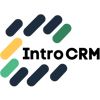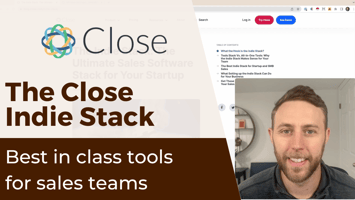I'm thrilled to announce a groundbreaking project we've been working on with our partner, Close.
How to use sales demographics to sell better
In our last post, we talked about how to use firmographic data in your sales prospecting. Today, let’s talk about segmenting using demographic data in the sales process to help define our ideal sales demographics.
Demographics for B2B sales
Demographics are used to understand the social makeup of populations. The typical numbers focus on things like education, nationality, and religion. In this case, we’re using this term to talk about the social makeup of a business. And specifically, the people working within that business.
We work primarily with companies selling B2B products or services, so we’re going to focus on the demographics we use in that process. If you’re running a B2C business, this strategy may not work for you.
It bears acknowledging that when you are sales prospecting, there is a person on the other side of your email, phone call, or tradeshow booth. And there are shared traits that we can hone in on to improve the results in our search for new customers.
When it comes to sales demographics in the workplace, the biggest one we focus on is job title.
Still, it’s not as easy as you may think. It turns out job titles are the homophones of the business world. They all seem the same but often have a slight difference in their makeup, resulting in different uses and cases.
For example, when we think of the management C-level roles, we often think about the decision-making power they hold based on what they do. A CFO might decide a specific thing in some companies, whereas in others, maybe it’s the COO. This can vary based on experience, industry, and company size.
Another thing to consider is title inflation within smaller companies. They have higher titles because they have more responsibility but may be less experienced and/or be more into the details of doing work daily.
One interesting situation is when a title has multiple uses. For example, a title with the word “account” in it. This could be an existing customer sales/support account manager. Or they could be a project manager purely focused on delivery. They could even be a new customer sales role.
What is their experience and time in this role? If they’re earlier in their career and it’s the first time doing the role—everybody starts there at some point, right?—you may approach them differently than if they have been doing this role for decades.
If they’re experienced but new to the role, they’re likely spending the first six-twelve months evaluating their team and tools. They’re probably busy. But hey, it’s also a great time to get in front of them with something new while things are in flux.
Beyond job title and tenure, other sales demographics considerations are management level and location.
Are they an executive, manager, or individual contributor?
Along these lines: Where are they based, geographically? This firmographic data connects at the individual level too. If they are in the corporate office, a field office, or another type of facility, those sales demographics insights are part of the story.
And within their level of management, what kind of resources are at their disposal? Think broadly about not only the team size and budget, but also about the technologies available to them in their work. (We’ll dive deeper into Technographic data in a later post.)
With these complexities, it’s essential to test your assumptions against real-world data and find real people with the job titles you have in mind.
The best way to do this customer development work? Sorry, but it’s manually.
When we help Intro CRM customers find new business, we build lead lists that include personal LinkedIn profiles. We review them—and our customers review them too. We get a rating for every contact and we use that to improve over time. Looking at individual LinkedIn profiles is a great way to get a real sense of how other people think of their role and how to describe it. This type of sales demographics work is nuanced at first, until you spot trends and patterns.
How to define sales demographics
This process can be a little bit like trial and error. However, using what you already know about the firmographics of the companies you work with, you can more easily replicate successful title-based prospecting.
If you’re new to the idea of sales demographics, here are a few prompts to help you get the ball rolling.
- Talking the Talk. If you sell a niched product, or maybe something industry-specific, you want to speak to someone who speaks your language. Think about a tech product. You wouldn’t necessarily want to talk to the CEO. You might want to chat with the CTO because they will understand the technical benefits of your product. On the other hand, they might not get into the details of purchasing decisions like this. There may be an engineering manager, or someone in DevOps, who is actually responsible for the tools that the team uses.
- Finding the Buyer. When it comes to selling to smaller companies, it’s crucial to think about the people who have buying power. It may be inconvenient, but realistically in smaller companies, the buying power is typically held by the CEO. After all, odds are good that they are the operations manager, the founder, the main salesperson, and probably so much more—they are still interacting with the company’s most significant pain points. They have the buying power to make a conversation fruitful.
- Finding Interest. Imagine you’re selling a product that affects the culture of an organization. Maybe it’s a learning product or collaboration tool. Your first instinct might be to try to sell to HR (Human Resources). Are you sure that’s what they focus on? In many companies, HR focuses on legal liability, benefits, and administrative matters. They may be a driver of organizational change. Or maybe not. There may be someone else who is more focused on driving change and bringing new tools to the business. In this case, you’re looking for someone with both the attitude and the interest—not just the title.
How Intro CRM can help
Prospecting is hard! It’s time-consuming, confusing, and at times, downright frustrating or defeating. Putting time and energy into collecting leads that could care less is discouraging. It can be hard to spin up a story about the sales demographics of your customers that isn’t true, or at least is unproven. We’ve been there, and that’s why we’re here now.
Outbound sales can be draining because you don’t always have access to a dream team of people ready to leverage their expertise for every step of the process. But how does this work?
At Intro CRM, we solve this by bringing a repeatable process, best practices, premium tools, and know-how. Our goal is to develop a repeatable method for discovering new prospective customers.
We begin the sales demographics research process by asking you to define your ideal lead and contacts. We build an initial list and you rate them for quality.
We do this weekly, getting fresh cohorts of leads based on our latest learnings. Led by our sales experts who are serving our entire portfolio of customers, using a suite of tools proven to have accurate and comprehensive data.
Once we have a general picture of the people you want to sell to, we need to start copywriting. Subject lines and emails. LinkedIn messages. We’ll start with some base templates and individualized content for each lead.
When we feel those are ready, we queue them up into sequences with an agreed upon frequency, duration, tone, and overall call to action our desired outcome.
Then we start sending emails.
We run reporting to optimize performance of the funnel each step of the way. Combining human creativity for a personal touch, with automation to save time and money.
You saw above that we do a lot of work before sending our first message. Yep. It’s a lot of work! We’re not a spam factory. We’re your virtual sales assistant, so we’re here to help along the way and save you time. We sell in a way that you can be proud to try for your business. Sure, post is about sales demographics but there’s a lot more that goes into it than just that.
You know the old saying, nothing is certain but death and taxes. There’s no guaranteed way to find new customers. But the right approach can increase your odds. Our goal is to create a repeatable method to acquire new customers.
Your business might not have time to wait for SEO, a budget for paid advertising, connections for public relations, or a team for content marketing. You may not know the sales demographics of your ideal customer profile.
Or if you have mastered another one of these channels, remember: there are diminishing marginal returns on any one channel and untapped potential in new channels. Not to mention the concentration risk of high leverage channels that can change out of your control—like a change in search algorithms for example.
Worst case scenario? If our sales approach doesn’t work, we’ll have a sense of which step failed.
Couldn’t find leads? Maybe too niche. Couldn’t get opens? Perhaps a bad pitch. Couldn’t get replies? There’s something off about the offer. Maybe it’s the pricing or positioning or something else. We’ll have to extrapolate from the replies we did get.

